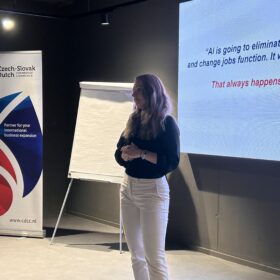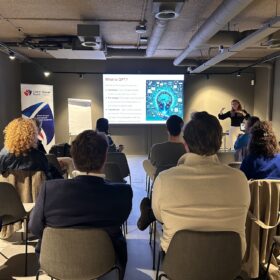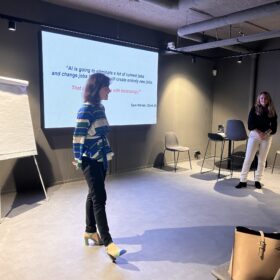News
How to get the best out of AI for small businesses
Whether we want it or not, AI is infiltrating numerous fields and is all around us. Many companies, various institutions as well as individuals are using one or more of countless AI tools. How can we leverage AI to improve our productivity? How and which tools can we use for our personal needs and which for business purposes? How can it help small and medium-sized companies to boost their productivity, increase sales, or get better in marketing?
Zdenka de Booij, a subject matter expert in AI and an active member of the Women in AI and Women in Tech communities, shared her experiences with AI tools during the seminar “How to get the best out of AI for small businesses” hosted by the Czech-Slovak Dutch Chamber of Commerce on 5 June in Amsterdam. Here are the main takeaways.
Zdenka de Booij has been working in the fields of technology, data analytics, and online marketing for several years and currently works as a consultant for an international consultancy firm.
When starting with any AI tools, it’s important to take small, manageable steps. Begin by selecting a specific tool that aligns with your needs. For instance, if your work involves frequent writing, try a language processing tool like ChatGPT. Zdenka advises: “Experiment with the tool on real tasks to understand how it can simplify or enhance your performance.” Additionally, use AI to automate routine and time-consuming tasks. AI can also improve the quality of your work, whether it’s through more accurate data analysis or creating personalized marketing campaigns. Lastly, connect with other professionals or friends who are already using AI tools. Sharing experiences and tips can be incredibly beneficial in maximizing the effectiveness of these tools.
A specific example of how you can use AI tools
As an Account Manager, you can leverage data through Account-Based Selling by creating your own chatbot within ChatGPT-4o (paid version). You can upload your service or product information, and the chatbot can help generate personalized emails or provide an overall profile of the company you want to target, creating a complete strategy for you. Additionally, you can request a competitive overview with outputs available in Excel, tables, CSV data, or even presentations.
Prompt engineering
Prompt engineering in AI tools is essential as it directly impacts the quality and efficiency of human-AI interactions. Well-crafted prompts help users convey their intentions effectively, leading to more accurate and relevant responses from AI systems.
Clear instructions:
When interacting with AI tools, providing clear and concise instructions is crucial. For example, instead of asking “Tell me about productivity” you might say “List five ways to improve productivity in remote work environments.”
Adopt a persona:
Sometimes, it helps to specify a persona for the AI to adopt. For example: “Respond as a seasoned project manager with experience in agile methodologies.”
Specify the format:
Indicate the desired format for the response. For instance, “Provide the information in bullet points” or “Write a summary in three paragraphs.”
Avoid leading the answer:
Ensure that your prompt does not lead the AI to a specific answer. Instead of saying, “Why is remote work better?” you might ask, “What are the pros and cons of remote work?”
Limit the scope:
Narrowing the scope of your question can yield more relevant results. For example, instead of asking “How can technology improve business?” you could ask “How can AI improve customer service in small retail businesses?”
Katerina Veliskova, Executive Director of CDCC added: “When I work with ChatGPT, I deal with it the way I would with a copywriter, translator, subject matter expert. The way I would brief a human, I prompt ChatGPT and it works.”
Utilizing AI Tools in Various Business Functions
AI tools can be harnessed effectively in marketing, sales, and data analysis. In marketing, AI can automate content generation, leveraging tools like ChatGPT and MidJourney to create engaging content quickly. These tools can generate blog posts, social media updates, and even complex reports, saving valuable time and resources.
In sales, AI-powered scheduling apps can optimize appointments, coordinate team calendars, and send automated reminders to customers. This not only streamlines the scheduling process but also ensures that no opportunities are missed. Account-based selling strategies can be enhanced with GPT, allowing for personalized communication and better client engagement.
For data analysis, business analytics software powered by AI can track key metrics, uncover trends, and make data-informed decisions. Tools like ChatGPT and Gamma can be used to create chatbots that facilitate data collection and analysis. These chatbots can interact with customers, gather feedback, and provide insights that help businesses improve their productivity and make smarter decisions.
Examples of Other AI Tools
Grammarly: Grammarly uses AI to provide grammar and style suggestions in real time. It helps improve writing clarity, making emails, reports, and other documents more professional and error-free. By catching errors and suggesting improvements, Grammarly enhances the overall quality of written communication.
Zapier: Zapier connects different apps and automates workflows. For example, it can automatically save email attachments to cloud storage and notify your team in Slack, reducing manual workload and increasing efficiency. Zapier’s ability to link various applications streamlines processes and saves time.
FutureTools.io: FutureTools.io curates a list of the latest AI tools and applications, helping businesses stay updated with emerging technologies. By exploring and adopting these new tools, companies can gain a competitive edge and continuously improve their operations.
Canva: Canva uses AI to assist in graphic design, offering templates and tools for creating professional visuals quickly. Whether for marketing materials, social media posts, or presentations, Canva makes it easy for anyone to produce high-quality designs without extensive graphic design experience.
MidJourney: MidJourney is an AI tool that aids in content creation by generating creative and engaging media. It can be used for producing visuals, videos, and interactive content, enhancing marketing efforts, and keeping audiences engaged.
DeepL: DeepL provides highly accurate translations using AI. It helps break language barriers by offering precise translations for documents, web content, and communications, making it easier to connect with a global audience.
Runway: Runway offers a suite of AI tools designed for creative professionals. It includes features for video editing, image generation, and other creative processes, enabling users to produce high-quality multimedia content efficiently.
Gamma.app is a modern AI-powered tool designed to create engaging presentations and documents. It simplifies the process of content creation, allowing users to produce visually appealing and interactive presentations, websites and documents.
There are countless other AI tools available, each designed to address specific needs and improve various aspects of personal and professional workflows. By leveraging these tools and implementing effective prompt engineering, businesses and individuals can significantly boost their productivity. AI tools not only automate repetitive tasks but also enhance creativity and decision-making, leading to more efficient and effective workflows.
What is your favourite AI tool? Let us know at info@cdcc.nl and stay tuned for other events.
To write this article, the ChatGPT tool was used for summarizing and providing descriptions of individual example tools.





